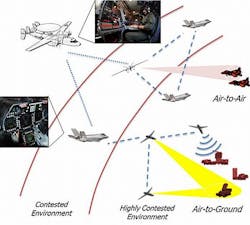DARPA releases solicitation for DBM program to plan air battles with limited communications
Officials of the Defense Advanced Research Projects Agency (DARPA) in Arlington, Va., on Friday released a solicitation (DARPA-BAA-14-17) for the Distributed Battle Management (DBM) program, which seeks to develop flexible planning software for aircraft onboard systems.
DBM planning tools would help U.S. and allied aircraft avoid threats and attack targets in the presence of jamming or other countermeasures that limit the abilities of communications and sensor networks against large and formidable threats.
DARPA will brief industry on the DBM program this Friday, 28 Feb. 2014, at the DARPA conference Center, 675 North Randolf St., in Arlington, Va.
The DBM decision aids will be integrated into on-board software and will help airborne battle managers and pilots maintain situational awareness, recommend tasks, generate detailed fighting plans, and keep control of the fight, DARPA officials say. DARPA scientists say they believe current research has matured sufficiently to choose algorithms to meet the needs for airborne battle decision aids.
Related: DARPA to brief industry on software tools to plan air battles with manned aircraft and UAVs
Consider an air-to-air mission with a Navy E-2D battle management aircraft, unmanned aerial vehicle (UAV) with infrared search and track (IRST) capability, several F-35 strike fighters, and weapons. Focus on one target, and assume limited communications without tactical data links or SATCOM, and ineffective surveillance radar due to jamming.
In these conditions planners could rely on other sensors, other data routing, and other decision makers than what they're used to. Planners could rely on the UAV's infrared sensors and communications relays to protect aircraft and find targets, DARPA researchers say.
If the UAV sensors detect a target, the E-2D's DBM tools could fuse the data to geolocate, identify, and track the targets. The DBM tools, furthermore, could lay out several options ranked by risk and likelihood of success. Orders to available attack aircraft could flow through the E-2D and perhaps even the UAV.
When the problem scales to a realistic threat with hundreds or thousands of targets, DBM might manage manned and unmanned aircraft teams for weapons, sensors, and jamming, DARPA researchers say.
The challenge for the DBM program is to build new algorithms that are reliable against realistic threats, including, integrating the software onto real aircraft, and demonstrating it in simulated combat.
The first phase of the DARPA DBM program focuses on developing algorithms and human-machine interfaces. For this phase several contractors may be chosen to split a phase-one program budget of about $10.1 million.
Related: Combat aircraft with advanced avionics
Some winning contractors will focus on concepts of operation, and others will focus on system prototypes. Later, if the program moves forward, a second phase will build an integrated DBM capability and demonstrate it in large-scale simulations and live fly events.
Companies interested should send abstracts to DARPA no later than 11 March 2014, and full proposals no later than 22 April 2014. Program details and submission guidelines are online in Microsoft Word form at https://www.fbo.gov/utils/view?id=ebc8adf6a3daa466a6f51a783af10a30. Email questions or concerns to DARPA at [email protected].
More information is online at https://www.fbo.gov/spg/ODA/DARPA/CMO/DARPA-BAA-14-17/listing.html.
